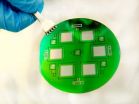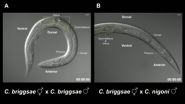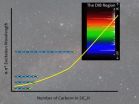(Press-News.org) NASA technologists have hurdled a number of significant technological challenges in their quest to improve an already revolutionary observing technology originally created for the James Webb Space Telescope.
The team, led by Principal Investigator Harvey Moseley, a scientist at NASA's Goddard Space Flight Center in Greenbelt, Maryland, has demonstrated that electrostatically actuated microshutter arrays — that is, those activated by applying an specific voltage — are as functional as the current technology's magnetically activated arrays. This advance makes them a highly attractive capability for potential Explorer-class missions designed to perform multi-object observations.
"We have identified real applications — three scientists want to use our microshutter arrays and the commercial sector has expressed interest," said Mary Li, a Goddard engineer who is working with Moseley and other team members to fully develop this already groundbreaking observing technology. "The electrostatic concept has been fully demonstrated and our focus now is on making these devices highly reliable."
Progress, she said, is in large part due to the fact that the team successfully eliminated all macro-moving parts — in particular, a large magnet — and dramatically lowered the voltage needed to actuate the microshutter array. In addition, the team applied advanced electronic circuitry and manufacturing techniques to assure the microshutter arrays' dependable operation in orbit, Li added.
The Microshutter Breakthrough
Considered among the most innovative technologies to fly on the Webb telescope, the microshutter assembly is created from micro-electro-mechanical technologies and comprises thousands of tiny shutters, each about the width of a human hair.
Assembled on four postage-size grids or arrays, the 250,000 shutters open or close individually to allow only the light from targeted objects to enter Webb's Near Infrared Spectrograph (NIRSpec), which will help identify types of stars and gases and measure their distances and motions. Because Webb will observe faint, far-away objects, it will take as long as a week for NIRSpec to gather enough light to obtain good spectra.
NIRSpec's microshutter array, however, enhances the instrument's observing efficiencies. It will allow scientists to gather spectral data on 100 objects at a time, vastly increasing the observatory's productivity. When NASA launches the Webb telescope in 2018, it will represent a first for multi-object spectroscopy.
Quest to Improve Design
Determined to make the microshutter technology more broadly available, Goddard technologists have spent the past four years experimenting with techniques to advance this capability.
One of the first things the team did was eliminate the magnet that sweeps over the shutter arrays to activate them. As with all mechanical parts, the magnet takes up space, adds weight, and is prone to mechanical failure. Perhaps more important, the magnet cannot be easily scaled up in size without creating significant fabrication challenges. As a result, the instrument's field of view — that is, the area that is observable through an instrument — is limited in size. This greatly impedes next-generation space observatories that will require larger fields of view.
Magnetic activation also takes longer. With the Webb telescope, the magnet must first sweep over the array to open all the shutters before voltages are selectively applied to open or close specific shutters.
Achieving the Voltage Sweet Spot and Other Milestones
To accommodate the needs of future observatories, the team replaced the magnet with electrostatic actuation. By applying an alternating-current voltage to electrodes placed on the frontside of the microshutters, the shutters swing open. To latch the desired shutters, a direct current voltage is applied to electrodes on the backside. In other words, only the needed shutters are opened; the rest remain closed. "This reduction in cycles should allow us to extend the lifetime of the microshutter arrays 100 times or more," Li explained.
And because the magnet no longer dictates the size of the array, its elimination will allow scientists to assemble much larger arrays for instruments whose fields of view are 50 times larger than Webb's NIRSpec, she said.
Just as significant is the voltage needed to actuate the arrays. When the effort first began four years ago, the team only could open and close the shutters with 1,000 volts. By 2011, the team had slashed that number to 80 volts — a level that still could exceed instrument voltage specifications. By last year, the team had achieved a major milestone by activating the shutters with just 30 volts — a voltage sweet spot, Li said.
"But we also did something else," she added.
Through experimentation, the team used atomic layer deposition, a state-of-the-art fabrication technology, to fully insulate the tiny space between the electrodes to eliminate potential electrical crosstalk that could interfere with the arrays' operation.
The team also applied a very thin anti-stiction coating to prevent the shutters from sticking when opened. Before applying the coating, a 3,000-cycle laboratory test indicated that a third of the shutters stuck. After coating them, the team ran a 27,000-cycle test and not a single shutter adhered to the sides, Li said.
Success Breeds Success; More Work Ahead
As a result of the progress, Li said three astrophysicists now are interested in applying the technology to their own mission concepts, which include observing nearby star-forming regions in the ultraviolet, studying the origins of astronomical objects to better understand the cosmic order, and understanding how galaxies, stars, and black holes evolve. In fact, one of those scientists is so committed to advancing the microshutter array that he plans to demonstrate it during a sounding-rocket mission next year, Li said.
Although spectroscopy — the study of the absorption and emission of light by matter — is the obvious beneficiary of the technology's advance, Li said it also is applicable to lidar instruments that measure distance by illuminating a target with a laser and analyzing the reflected light. A major automotive company also has expressed interested in the technology, she added.
However, before others can use the new and improved microshutter technology, Li said the team must develop an assembly and packaging to house multiple arrays. "If you want to use the microshutter array on a large telescope, we need to make a larger field of view. To make this happen, we need to take multiple arrays and stitch them together," Li said.
Currently, the technology relies on a large computerized switch box — a heavy device unsuitable for spaceflight missions. The team plans to incorporate an integrated circuit, or silicon chip, that drives the switching functions. Placed next to the shutters, the circuit would take up only a fraction of the space. The team currently is identifying circuits from different vendors and plans to begin testing shortly.
"In just four years, we have made great progress. A major private company has expressed interest in our technology, to say nothing of the three potential astrophysics missions," Li said. "Given our progress, I am confident that we can make this technology more readily accessible to the optics community."
INFORMATION:
Revolutionary microshutter technology hurdles significant challenges
2014-07-29
ELSE PRESS RELEASES FROM THIS DATE:
Study: Contrary to image, city politicians do adapt to voters
2014-07-29
Political scientists have long wondered whether city governments in the U.S. are really responsive to their voters. Aren't local governments simply mired in machine politics, or under the sway of local big-money interests? Does ideology matter?
Now a uniquely comprehensive study co-authored by an MIT political scientist has produced a pair of distinctive findings: first, that the policies of city governments do closely match the politics of their citizens, and second, that this occurs regardless of the exact form of government than a city has.
That means that urban ...
Short sellers not to blame for 2008 financial crisis, study finds
2014-07-29
BUFFALO, N.Y. – Contrary to widespread media reports, the collapse of several financial firms during the 2008 economic crisis was not triggered by unsettled stock trades, according to new research from the University at Buffalo School of Management.
The study, forthcoming in the Journal of Financial Economics, analyzed the open interest of fails-to-deliver — stock trades in which shares are not delivered within the three-day trading cycle — in the days before and after the stock crashes of American Insurance Group, Bear Stearns, Lehman Brothers and Merrill Lynch.
The ...
Informal child care significantly impacts rural economies, MU study finds
2014-07-29
COLUMBIA, Mo. – The child care industry has grown significantly in recent years, contributing considerably to the national economy through job creation and increased opportunities for parents to work. However, little knowledge exists of the size and economic impact of child care, especially informal child care, on rural economies. Now, University of Missouri researchers have studied the child care sector in Kansas, particularly in rural areas, and have found that informal child care services create a large economic impact in the state.
Tom Johnson, a professor in the ...
Malaria vaccine shows continued protection during 18 months of follow-up
2014-07-29
A vaccine previously shown to reduce malaria in young infants and children reduces larger numbers of malaria cases in areas of higher malaria transmission, according to results from an ongoing clinical trial published in PLOS Medicine. The effect of vaccination diminished over time, but protection against clinical malaria remained evident 18 months after vaccination.
In the new report, the RTS,S Clinical Trials Partnership* update estimates of vaccine efficacy (the reduction in the risk of malaria in participants who received the vaccine compared to those who received ...
Small increases in Ugandan urbanicity tied to CVD risk factors
2014-07-29
Urban dwellers tend to have higher risk for cardiovascular diseases than people living in more rural locations. In a new study published in PLOS Medicine, Johanna Riha and colleagues, researchers from the University of Cambridge and the MRC/UVRI Research Unit in Uganda, have found that even within rural communities in Uganda that all lacked paved roads and running water, people living in villages with relatively more urban features—such as schools and health facilities –were more likely to have risk factors for cardiovascular diseases such as physical inactivity, lower ...
'Killer sperm' prevents mating between worm species
2014-07-29
VIDEO:
These are time-lapse videos of Caenorhabditis hermaphrodites that were (A) mated with the same species and (B) mated with a different species. Male sperm were fluorescently labeled and appear as...
Click here for more information.
The classic definition of a biological species is the ability to breed within its group, and the inability to breed outside it. For instance, breeding a horse and a donkey may result in a live mule offspring, but mules are nearly always sterile ...
Urbanization of rural Africa associated with increased risk of heart disease and diabetes
2014-07-29
The increasing urbanisation of rural areas in sub-Saharan Africa could lead to an explosion in incidences of heart disease and diabetes, according to a new study carried out in Uganda which found that even small changes towards more urban lifestyles was associated with increased risk of cardiovascular and metabolic diseases.
Over 530 million people live in rural areas of sub-Saharan Africa, where rates of cardiovascular and metabolic diseases tend to be much lower than in urban areas. However, many of these areas are becoming increasingly urbanised, with people living ...
Mysterious molecules in space
2014-07-29
WASHINGTON D.C., July 29, 2014 – Over the vast, empty reaches of interstellar space, countless small molecules tumble quietly though the cold vacuum. Forged in the fusion furnaces of ancient stars and ejected into space when those stars exploded, these lonely molecules account for a significant amount of all the carbon, hydrogen, silicon and other atoms in the universe. In fact, some 20 percent of all the carbon in the universe is thought to exist as some form of interstellar molecule.
Many astronomers hypothesize that these interstellar molecules are also responsible ...
This week from AGU: Cell tower rain gauges, lightning channels, North Sea storm surge
2014-07-29
This Week From AGU: Cell phone tower rain gauges, lightning channels, North Sea storm surge
From AGU's blogs: Dropped cell phone calls become rain gauges in West Africa
A shaky cell phone connection during a rainstorm can be an annoying nuisance. But now scientists are showing that these weakened signals can be used to monitor rainfall in West Africa, a technique that could help cities in the region better prepare for floods and combat weather-related diseases, according to a new study accepted for publication in Geophysical Research Letters, a journal of the American ...
Penn team makes cancer glow to improve surgical outcomes
2014-07-29
The best way to cure most cases of cancer is to surgically remove the tumor. The Achilles heel of this approach, however, is that the surgeon may fail to extract the entire tumor, leading to a local recurrence.
With a new technique, researchers at the University of Pennsylvania have established a new strategy to help surgeons see the entire tumor in the patient, increasing the likelihood of a positive outcome. This approach relies on an injectable dye that accumulates in cancerous tissues much more so than normal tissues. When the surgeon shines an infrared light on the ...




